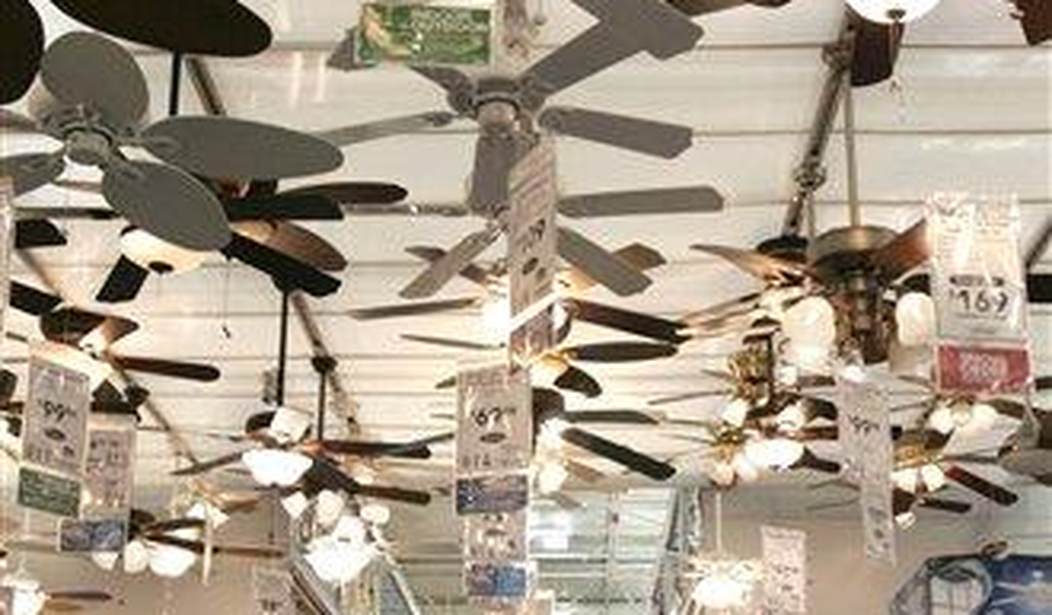Just in case you’ve lost track at home of all the conveniences of life you are not to be afforded in the near future, thanks to regulations either already implemented or pending by the Joe Biden administration, let me help remind you.
Beef, despite the commercials, is not what’s for dinner, if this government had their way. Methane from both the north and south ends of cattle is responsible for one-third of three percent of greenhouse gases, and yet our inevitable extinction can only be headed off by the extinction of bovine everywhere, or at the very least, hosing off both ends and capturing and sequestering what eventually happens.
Gas stoves were a subject of regulation until the public caught wind of the idea and revolted. Energy Secretary Jennifer Granholm laughed at you for thinking the government was even thinking about the idea, it was so preposterous to her. Except that’s exactly what they were doing. And not only that, they are coming after lightbulbs, dishwashers, furnaces, and don’t even get me started on air conditioning.
Water heaters are also in the Biden regulatory crosshairs. And if you think new regulations don’t eventually mean more costs and less choices for consumers, you’re fooling yourself. Washing machines and refrigerators are all going to be more expensive in the future, specifically because of this government’s intent to regulate them to the point where only the biggest of companies can still absorb the increased cost to make them. They will naturally pass those costs onto consumers. Smaller manufacturers will simply go out of business.
The Biden administration, as well as their satellite leftist branches in blue states, are doing the best they can to force you into electric vehicles instead of gas-burning cars. Yet in states like California, they’re simultaneously expecting you not to actually charge the dumb things during peak hours when the grid is taxed. And they’re floating the idea of reversing the flow and draining what juice you do have in the battery if they need it in a pinch to keep the grid up and running. So is that all they’ve got? Is there anything else that might make life a smidge more comfortable that they’re trying to destroy? Why, yes. Yes, there is.
Hillary Vaughn broke the news on Fox Friday, that even though you might be experiencing some hot weather where you are, don’t think you’re going to just be able to turn your ceiling fans on high and the world’s going to be okay with it.
Ceiling fans inherently use less energy than air conditioners. There is not a condenser or a furnace system being deployed to pump cold air everywhere. They are, or soon-to-be were, a relatively low-cost way to circulate airflow in a room of the house in order to cool it down so you can spare the use of an air conditioner, if indeed you have one of those in the house. But that’s not good enough for the Biden administration.
The proposed rule is an attempt for force domestic and international ceiling fan companies to reengineer their devices in order to make them up to 40% more energy efficient. Why are we so worried about that if they’re running on clean electricity? It’s not like they’re hooked up to diesel generators, right? I thought we were supposed to be doing everything via electricity, because it all comes from the solar panels and wind turbines that are in every city and town in the country. We’re supposed to dump furnaces for heat pumps. All the electricity we’ll ever need comes from green energy, so there shouldn’t even need to be the requirement to make them more efficient, or so we’ve been told. Except that by admitting that their desire is to make devices more efficient in order to get closer to our net zero carbon footprint, they’re admitting that wind and solar do not provide the energy as advertised, we’re nowhere near getting to that point in the near future, and that the vast majority of our electric grid still comes from fossil fuels, hydro or nuclear. So maybe unwittingly, they’re giving the game away with the request for the rule in the first place.
Second, here’s the math behind the regulation. We still live in a mostly-free society. You do not currently have to register the ceiling fan you pick up at the Home Depot with the government and get a permit in order to install one. Uncle Sam, unless he’s been busy droning the inside of your house against your will, doesn’t have the foggiest idea how many, if any, ceiling fans you have in your home. They can certainly track the number of ceiling fans that are sold annually, which is currently a $12 billion dollar market. That’s somewhere around 20 million fans sold a year.
While the shape and styles of the ceiling fans have changed a bit over the years, the basic motor and wiring of the fans have remained relatively unchanged for decades. I know, because I’ve been installing them myself for about as long. I don’t even have to use the directions anymore, because if you’ve done one, you’ve done them all. But now, that’s all about to change. So what do we get for all the regulatory change? Well, not much.
According to the Department of Energy, the first data point they’re featuring is naturally the savings to customers. The savings of you buying a new ceiling fan, once the regulations work their way through the production pipeline, will be $39 dollars over the life of the fan. Any of you have a ceiling fan in your house? How old is it? What’s that? You can’t remember? That’s because they last an awfully long time.
The lowest reasonable life expectancy of a standard ceiling fan is ten years, and that’s when they’re in use virtually all the time on their highest setting. Most of the country, including where I’m at, use them seasonally, and therefore get a lot longer lifespan on the motor. I’ve got some that are still going strong at 20 years. But your mileage, or RPM’s, may vary.
But let’s use the 10-year mark for the purposes of this exercise. And just because I’m in a charitable mood, I’ll give the government the scenario that I bought the new fan on a leap year, so that’s 7 years at 365 days, 3 years of 366 days before it conks out. That’s 3,653 days of life. You’re saving, by the DOE’s own data, $39 dollars. That’s literally saving you $.01 a day per fan in hour house. Let’s say you’re living large. You have four fans. That’s, checks math, $.04 cents a day you’re saving over ten years. Don’t spend it all in one place.
The cost? Well, the government is kinda keeping that on the downlow, but the regulatory cost to ceiling fan manufacturers is estimated to be somewhere north of $86.6 million per year, according to Fox News. There’s 20 million fans sold a year, industry-wide. If you’re a small company manufacturing ceiling fans, this is a death knell to you. You’re not going to have the capital laying around to retool and front-load the production costs. So you’ll have smaller companies go out of business, larger companies offering less choices of fans, and having to recoup the production costs in the form of price hikes to consumers. The DOE can do a lot of things, but it can’t keep the market from responding to artificial edicts on the supply and demand curve.
Oh, but the energy you’ll save, right? It’s going to be 40% more efficient, so you’ll be saving boatloads on your electricity bill. Anyone have an idea how much electricity an average ceiling fan uses? I do…now. I checked.
A medium-sized ceiling fan uses 50.4 kilowatt hours per month. Let’s just say you replace it and it is indeed 40% more efficient. That means you’re now only using 28.8 kilowatt hours. You’re saving 21.6 kilowatt hours per month. In California, we’re paying ridiculously high kilowatt hour prices – $.20 per kWh. Other states are half that. I’d be saving less than $6 bucks a month per fan. In Arkansas, I’d be saving less than $3 bucks a month per fan. You’ll forgive me if I don’t act like I just won the lottery.
Secretary Granholm’s DOE claims,
hardworking taxpayers up to $369 million per year, while substantially reducing harmful air pollution — a crucial fact that some have conveniently failed to mention.
Again, what’s being failed to mention is that if you drive a Tesla, you’re contributing mightily to air pollution. You just are. It requires electricity to run the things, and we’re already accepting in the premise the feds are using to create the regulation coming for your ceiling fans that we have to do this in order to lower air pollution. I can’t even imagine how much harm we’re doing to the environment with electric buses and trucks.
But $369 million a year in savings? There’s liars, dirty liars, and statistics. I’ve got some stats for you.
In 2001, the last study I could actually find for how many ceiling fans are in use in the United States, it was around 193 million fans. It almost certainly is up in number from then. Let’s say it’s 200 million fans in use. It allows for growth in population and number of homes in the last 20 years, and is easier math. Again using the DOE’s savings metric of $39 over the lifespan of the fan, which we’ll going with 10 years, and you counted the average 20 million units sold in the U.S., your daily savings per fan with the new regulation, is $213,523 dollars a day, nationwide. That’s a smidge under $80 million a year. The DOE is trying to tell you that the American people could save up to $369 million a year. That’s nonsense.
The only way you get to that number is if every ceiling fan got replaced, every other year. If you multiply that $.01 cent savings per fan multiplied by 100-plus million fans, then you’re into that level of estimated savings as a country. But that’s all fuzzy math. It still boils down to you as an individual are saving about a penny a day per fan. That’s $3.65 a year, per fan. But the damage to an entire industry will be enormous.
Now you might conclude that all of this is lunacy, and being that it’s just a proposed regulation, you’ll just contact the Department of Energy and give them a piece of your mind. Tough. It’s too late. The public comment portion of the rulemaking process ended last Monday.
Been looking for that black market business on the side that you could get in on the ground floor? Ceiling fans. Buy lots and lots of ceiling fans.








